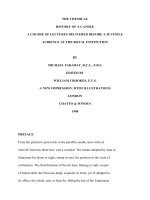Ebook A history of American movies: A film-by-film look at the art, craft, and business of cinema - Part 1
Bạn đang xem bản rút gọn của tài liệu. Xem và tải ngay bản đầy đủ của tài liệu tại đây (619.34 KB, 233 trang )
A History of
American Movies
A Film-by-Film Look at the
Art, Craft, and Business of Cinema
Paul Monaco
THE SCARECROW PRESS, INC.
Lanham • New York • Plymouth, UK
2010
Published by Scarecrow Press, Inc.
A wholly owned subsidiary of The Rowman & Littlefield Publishing Group, Inc.
4501 Forbes Boulevard, Suite 200, Lanham, Maryland 20706
Estover Road, Plymouth PL6 7PY, United Kingdom
Copyright © 2010 by Paul Monaco
All rights reserved. No part of this book may be reproduced in any form or by any
electronic or mechanical means, including information storage and retrieval systems,
without written permission from the publisher, except by a reviewer who may quote
passages in a review.
British Library Cataloguing in Publication Information Available
Library of Congress Cataloging-in-Publication Data
Monaco, Paul.
A history of American movies : a film-by-film look at the art, craft, and business of
cinema / Paul Monaco.
p. cm.
Includes bibliographical references and index.
ISBN 978-0-8108-7433-6 (cloth : alk. paper) — ISBN 978-0-8108-7434-3 (pbk. :
alk. paper) — ISBN 978-0-8108-7439-8 (ebook)
1. Motion pictures—California—Los Angeles—History—20th century. 2. Motion
picture industry—United States—Los Angeles—History—20th century. 3. Hollywood
(Los Angeles, Calif.)—History—20th century. I. Title.
PN1993.5.U65M55 2010
791.430973—dc22
2009051427
ϱ ™ The paper used in this publication meets the minimum requirements of
American National Standard for Information Sciences—Permanence of Paper
for Printed Library Materials, ANSI/NISO Z39.48-1992.
Printed in the United States of America
To my mother, Birdena O’Melia Monaco,
who was born in 1916, and who, like the
Hollywood movies, has grown since then
and continues to flourish.
Contents
Preface
1
2
3
4
5
6
vii
Part I: Classic Hollywood, 1927–1948
Establishing Hollywood
Early Synchronous Sound
Classic Hollywood Takes Form
Banner Years
Red, White, Blue, and Noir
Postwar Triumphs and Reversals
3
23
43
59
83
97
7
8
9
10
11
Part II: Hollywood in Transition, 1949–1974
Postwar Unravelings
Declining Audiences and Initial Responses
Hollywood on the Ropes
Indications of Revival
Conglomerate Control, Movie Brats, and Creativity
115
141
161
179
195
12
13
14
15
16
Part III: New Hollywood, 1975–2009
Origins of Hollywood Divided
Mixed Styles, Mixed Messages
Hollywood in the 1980s
New Hollywood Enters the Digital Age
Hollywood Enters the Twenty-First Century
217
233
245
273
313
v
vi
Contents
Conclusion
Selected Bibliography
Index
About the Author
335
339
341
349
Preface
This book is for the reader who wants to understand one of the most im-
portant cultural institutions of the twentieth century: the American cinema.
It is a history, but it is also a story. And telling any story requires selectively
choosing what to put in and what to leave out. A History of American Movies
chronicles an institution that had taken on its fundamental characteristics by
the year 1927, when the introduction of synchronous sound in film put an
abrupt end to the silent movies. This story is about a professional community
with its own ways of doing things, as well as a story about the relationships
between the many talented people belonging to that community.
Cinema is simultaneously an art, a craft, and a business. Art is best defined
as a human-produced object, text, or performance with limited practical utility but with added dimensions of meaning and value open to interpretation.
A sunset may be beautiful and engage the viewer’s emotions, but it is not
art. Like a sculpture, a coat rack may be a standing form made of wood and
metal—but it is not a sculpture, and is not considered art. How art is regarded
critically, and valued, is subject to complex development through cultural and
social institutions, education, and the opinions of various experts.
Motion pictures are made by various people who specialize in each of the
crafts that go into moviemaking, but always work collaboratively. Among the
major motion picture crafts are producing, screenwriting, directing, production management, cinematography, lighting, acting, production design, sound
recording, sound mixing, and editing. Hollywood professionals typically specialize in a single craft, although there is sometimes crossover of an individual
from one craft to another. Just how the collaboration of these various elements functions in the making of any particular movie is elusive. It is widely
recognized that making feature-length movies is collaborative. Just how this
vii
viii
Preface
collaboration works, however, usually is ignored or glossed over in thinking
and writing about what movies are and where they come from.
Finally, movies are a business, produced, distributed, and exhibited with
the intention of covering the costs of the materials and personnel needed to
make any individual movie, and with an eye to profitability. That profitability
is the margin that permits moviemaking and movie watching to continue.
A History of American Movies is a story told in recognition of the complexity of movies as an art, craft, and business. It is written, first of all, for
people who love movies and who would like to make them, especially for
those younger men and women who see themselves as the filmmakers of
the future. At the same time, it is a book written for readers of any age who
want to know what the American cinema is and truly has been, and how
those strands of art, craft, and business were woven together complexly
throughout Hollywood’s history.
The value of any Hollywood history depends on which movies are
written about, with an explanation of how they were selected as being
significant. Mentioning the titles of a great many movies in encyclopedic
fashion has value, but it is not the best way to tell the story of Hollywood.
Instead, this book focuses its attention on a select set of movies. The movies
selected are not choices of the author, however, nor of any other film critic
or film scholar. Instead, this history is based on the premise that the essence
of Hollywood is best revealed through those movies whose titles are found
on three lists that have been created primarily by professionals actually working in the movie industry.
The cinema of the United States has two “official” organizations. The
first is the Academy of Motion Picture Arts and Sciences, founded in 1927
by the leading motion picture production and distribution companies to
promote film as an art and a science. Very early in its history, the Academy
instituted awards of merit to recognize accomplishment in a wide range of
artistic and technical fields; the recipients of these awards receive statuettes
known as “Oscars.”
Forty years later, in 1967, the other official body, the American Film
Institute (AFI), was founded with the specific goal of training filmmakers and
preserving America’s film heritage. With initial funding from the National
Endowment for the Arts (NEA), the Motion Picture Association of America
(MPAA), and the Ford Foundation, AFI’s broad mission is to enrich and nurture the art of film in America. In addition to providing advanced graduate
education in film production, AFI has created various forms of recognition to
honor specific filmmakers and films.
Combined, the Academy and AFI provide us three lists of films recognized as exceptional.
Preface
ix
BEST PICTURE ACADEMY AWARDS
The first of these lists consists of the movies selected for the Best Picture award
by the Academy. The Academy is the Hollywood establishment; its membership consists of people working in the motion picture industry above the line
(studio executives, producers, screenwriters, actors) and craftspeople (production designers, actors, cinematographers, editors, sound recordists, sound
mixers, art directors, etc.), as well as other creative, performing, and business
personnel. Since its earliest years in the late 1920s, when the Academy’s membership comprised just over four hundred, it has eventually grown into an
organization with roughly six thousand voting members. The Academy’s Best
Picture Oscar winners for each year, beginning in 1927/28, have been selected
by a cross-section of professionals actually engaged in finding, developing, and
funding movie ideas, bringing them to the screen, and disseminating them to
the public. The Best Picture Academy Awards for each year are contemporary
awards of distinction based exclusively on the evaluation and judgment of
movie industry peers.
The Academy of Motion Pictures Arts and Sciences has selected a Best
Picture for each year by vote since 1927/28. The awardee normally is selected
from a list of five, or more, nominated films. The winners through 2008 are:
1927/28: Wings
1928/29: The Broadway Melody
1929/30: Cimarron
1931/32: Grand Hotel
1932/33: Cavalcade
1934: It Happened One Night
1935: Mutiny on the Bounty
1936: The Great Ziegfeld
1937: The Life of Emile Zola
1938: You Can’t Take It with You
1939: Gone with the Wind
1940: Rebecca
1941: How Green Was My Valley
1942: Mrs. Miniver
1943: Casablanca
1944: Going My Way
1945: The Lost Weekend
1946: The Best Years of Our Lives
1947: Gentleman’s Agreement
1948: Hamlet
1949: All the King’s Men
1950: All About Eve
1951: An American in Paris
1952: The Greatest Show on Earth
1953: From Here to Eternity
1954: On the Waterfront
1955: Marty
1956: Around the World in Eighty Days
1957: The Bridge on the River Kwai
1958: Gigi
1959: Ben-Hur
1960: The Apartment
1961: West Side Story
1962: Lawrence of Arabia
1963: Tom Jones
1964: My Fair Lady
1965: The Sound of Music
1966: A Man for All Seasons
x
Preface
1967:
1968:
1969:
1970:
1971:
1972:
1973:
1974:
1975:
1976:
1977:
1978:
1979:
1980:
1981:
1982:
1983:
1984:
1985:
1986:
1987:
1988:
In the Heat of the Night
Oliver!
Midnight Cowboy
Patton
The French Connection
The Godfather
The Sting
The Godfather, Part II
One Flew over the Cuckoo’s Nest
Rocky
Annie Hall
The Deer Hunter
Kramer vs. Kramer
Ordinary People
Chariots of Fire
Gandhi
Terms of Endearment
Amadeus
Out of Africa
Platoon
The Last Emperor
Rain Man
1989:
1990:
1991:
1992:
1993:
1994:
1995:
1996:
1997:
1998:
1999:
2000:
2001:
2002:
2003.
2004:
2005:
2006:
2007:
2008:
Driving Miss Daisy
Dances with Wolves
The Silence of the Lambs
Unforgiven
Schindler’s List
Forrest Gump
Braveheart
The English Patient
Titanic
Shakespeare in Love
American Beauty
Gladiator
A Beautiful Mind
Chicago
The Lord of the Rings: Return of
the King
Million Dollar Baby
Crash
The Departed
No Country for Old Men
Slumdog Millionaire
100 GREATEST AMERICAN FILMS (1996)
The second list of movie titles is the “100 Greatest American Films,” assembled by the American Film Institute for all movies made between 1896
and 1996 from the votes of working professionals in the cinema of the United
States. The 100 selected films were:
1.
2.
3.
4.
5.
6.
7.
8.
9.
Citizen Kane (1941)
Casablanca (1943)
The Godfather (1972)
Gone with the Wind (1939)
Lawrence of Arabia (1962)
The Wizard of Oz (1939)
The Graduate (1967)
On the Waterfront (1954)
Schindler’s List (1993)
10.
11.
12.
13.
14.
15.
16.
17.
Singin’ in the Rain (1952)
It’s a Wonderful Life (1946)
Sunset Boulevard (1950)
The Bridge on the River Kwai
(1957)
Some Like It Hot (1959)
Star Wars (1977)
All About Eve (1950)
The African Queen (1951)
Preface
18. Psycho (1960)
19. Chinatown (1974)
20. One Flew over the Cuckoo’s Nest
(1975)
21. The Grapes of Wrath (1940)
22. 2001: A Space Odyssey (1968)
23. The Maltese Falcon (1941)
24. Raging Bull (1980)
25. E.T.: The Extra-Terrestrial (1982)
26. Dr. Strangelove (1964)
27. Bonnie and Clyde (1967)
28. Apocalypse Now (1979)
29. Mr. Smith Goes to Washington
(1939)
30. The Treasure of the Sierra Madre
(1948)
31. Annie Hall (1977)
32. The Godfather, Part II (1974)
33. High Noon (1952)
34. To Kill a Mockingbird (1962)
35. It Happened One Night (1934)
36. Midnight Cowboy (1969)
37. The Best Years of Our Lives
(1946)
38. Double Indemnity (1944)
39. Doctor Zhivago (1965)
40. North by Northwest (1959)
41. West Side Story (1961)
42. Rear Window (1954)
43. King Kong (1933)
44. The Birth of a Nation (1915)
45. A Streetcar Named Desire (1951)
46. A Clockwork Orange (1971)
47. Taxi Driver (1976)
48. Jaws (1975)
49. Snow White and the Seven Dwarfs
(1937)
50. Butch Cassidy and the Sundance
Kid (1969)
51. The Philadelphia Story (1940)
52. From Here to Eternity (1953)
xi
53. Amadeus (1984)
54. All Quiet on the Western Front
(1930)
55. The Sound of Music (1965)
56. M*A*S*H (1970)
57. The Third Man (1949)
58. Fantasia (1940)
59. Rebel without a Cause (1955)
60. Raiders of the Lost Ark (1981)
61. Vertigo (1958)
62. Tootsie (1982)
63. Stagecoach (1939)
64. Close Encounters of the Third Kind
(1977)
65. The Silence of the Lambs (1991)
66. Network (1976)
67. The Manchurian Candidate (1962)
68. An American in Paris (1951)
69. Shane (1953)
70. The French Connection (1971)
71. Forrest Gump (1994)
72. Ben-Hur (1959)
73. Wuthering Heights (1939)
74. The Gold Rush (1925)
75. Dances with Wolves (1990)
76. City Lights (1931)
77. American Graffiti (1973)
78. Rocky (1976)
79. The Deer Hunter (1978)
80. The Wild Bunch (1969)
81. Modern Times (1936)
82. Giant (1956)
83. Platoon (1986)
84. Fargo (1996)
85. Duck Soup (1933)
86. Mutiny on the Bounty (1935)
87. Frankenstein (1931)
88. Easy Rider (1969)
89. Patton (1970)
90. The Jazz Singer (1927)
91. My Fair Lady (1964)
xii
92.
93.
94.
95.
96.
Preface
A Place in the Sun (1951)
The Apartment (1960)
GoodFellas (1990)
Pulp Fiction (1994)
The Searchers (1956)
97. Bringing Up Baby (1938)
98. Unforgiven (1992)
99. Guess Who’s Coming to Dinner
(1967)
100. Yankee Doodle Dandy (1942)
AFI invited more than 1,500 leaders from across the U.S. film community—
primarily screenwriters, directors, actors, cinematographers, producers, editors,
and studio executives—to choose the hundred greatest movies from a list of
four hundred nominated films.
Thirty-four of the movies on this American Film Institute list duplicate the
titles of the Oscar-winning Best Picture selections. To create this list, AFI distributed ballots to a jury of 1,500 motion picture industry leaders, consisting of
film artists, including directors, screenwriters, actors, editors, cinematographers,
production designers, sound technicians, and others, as well as to a limited number of select film critics and film historians. AFI’s guidelines permitted write-in
votes, thereby allowing jurors to nominate films not already on the list.
AFI asked its 1,500 jurors to use the following criteria in making their
selections:
• Feature-length fiction films only (narrative format typically over sixty
minutes in length)
• American films only (English language film with significant creative
and/or financial production elements from the United States)
• Critical commendation (formal commendation in print, including
awards from organizations in the film community and major film festivals)
• Major award winner (recognition from competitive events, including awards from organizations in the film community and major film
festivals)
• Popularity over time (including figures for box office adjusted for inflation, television broadcasts and syndication, and home video sales and
rentals)
• Historical significance (a film’s mark on the history of the moving image through technical innovation, visionary narrative devices, or other
groundbreaking achievements)
• Cultural impact (a film’s mark on American society in matters of style
and substance)
• Legacy (also enjoyed apart from the movie and evoking the memory
of its film source, thus ensuring and enlivening both the music and the
movie’s historical legacy)
Preface
xiii
100 YEARS . . . 100 MOVIES:
THE 10TH ANNIVERSARY EDITION
In 2006, the American Film Institute conducted a follow-up survey to celebrate the tenth anniversary of its original list of 100 Greatest American Films.
This voting, again, was based on the ballots of 1,500 motion picture industry
professionals. One major reason for this “updating” of the list was for the
voters to consider feature films released since 1996. In all, forty-three films
released between 1996 and 2006 were nominated for consideration, but only
four of them—The Lord of the Rings: The Fellowship of the Ring (2000), Saving
Private Ryan (1998), Titanic (1997), and The Sixth Sense (1999)—made the list.
A second reason was to allow for an expansion of the list of the original one
hundred titles produced by AFI and published in 1997. Twenty-three new
film titles appear for the first time on this second AFI list, which was published
in 2007. In A History of American Movies, the two AFI lists are treated as being
of equal value and importance.
1.
2.
3.
4.
5.
6.
7.
8.
9.
10.
11.
12.
13.
14.
15.
16.
17.
18.
19.
20.
21.
22.
23.
24.
Citizen Kane (1941)
The Godfather (1972)
Casablanca (1942)
Raging Bull (1980)
Singin’ in the Rain (1952)
Gone with the Wind (1939)
Lawrence of Arabia (1962)
Schindler’s List (1993)
Vertigo (1958)
The Wizard of Oz (1939)
City Lights (1931)
The Searchers (1956)
Star Wars (1977)
Psycho (1960)
2001: A Space Odyssey (1968)
Sunset Boulevard (1950)
The Graduate (1967)
The General (1927)
On the Waterfront (1954)
It’s a Wonderful Life (1946)
Chinatown (1974)
Some Like It Hot (1959)
The Grapes of Wrath (1940)
E.T.: The Extra-Terrestrial (1982)
25. To Kill a Mockingbird (1962)
26. Mr. Smith Goes to Washington
(1939)
27. High Noon (1952)
28. All About Eve (1950)
29. Double Indemnity (1944)
30. Apocalypse Now (1979)
31. The Maltese Falcon (1941)
32. The Godfather, Part II (1974)
33. One Flew over the Cuckoo’s Nest
(1975)
34. Snow White and the Seven Dwarfs
(1937)
35. Annie Hall (1977)
36. The Bridge on the River Kwai
(1957)
37. The Best Years of Our Lives
(1946)
38. The Treasure of the Sierra Madre
(1948)
39. Dr. Strangelove (1964)
40. The Sound of Music (1965)
41. King Kong (1933)
42. Bonnie and Clyde (1967)
xiv
43.
44.
45.
46.
47.
48.
49.
50.
51.
52.
53.
54.
55.
56.
57.
58.
59.
60.
61.
62.
63.
64.
65.
66.
67.
68.
69.
70.
71.
Preface
Midnight Cowboy (1969)
The Philadelphia Story (1940)
Shane (1953)
It Happened One Night (1934)
A Streetcar Named Desire (1951)
Rear Window (1954)
Intolerance (1916)
Lord of the Rings: The Fellowship
of the Ring (2001)
West Side Story (1961)
Taxi Driver (1976)
The Deer Hunter (1978)
M*A*S*H (1970)
North by Northwest (1959)
Jaws (1975)
Rocky (1976)
The Gold Rush (1925)
Nashville (1976)
Duck Soup (1933)
Sullivan’s Travels (1941)
American Graffiti (1973)
Cabaret (1972)
Network (1976)
The African Queen (1951)
Raiders of the Lost Ark (1981)
Who’s Afraid of Virginia Woolf?
(1966)
Unforgiven (1992)
Tootsie (1982)
A Clockwork Orange (1971)
Saving Private Ryan (1998)
72. The Shawshank Redemption
(1994)
73. Butch Cassidy and the Sundance
Kid (1969)
74. The Silence of the Lambs (1991)
75. In the Heat of the Night (1967)
76. Forrest Gump (1994)
77. All the President’s Men (1976)
78. Modern Times (1936)
79. The Wild Bunch (1969)
80. The Apartment (1960)
81. Spartacus (1960)
82. Sunrise (1927)
83. Titanic (1997)
84. Easy Rider (1969)
85. A Night at the Opera (1935)
86. Platoon (1989)
87. Twelve Angry Men (1957)
88. Bringing Up Baby (1938)
89. The Sixth Sense (1999)
90. Swing Time (1936)
91. Sophie’s Choice (1982)
92. GoodFellas (1990)
93. The French Connection (1971)
94. Pulp Fiction (1994)
95. The Last Picture Show (1971)
96. Do the Right Thing (1989)
97. Blade Runner (1982)
98. Yankee Doodle Dandy (1942)
99. Toy Story (1995)
100. Ben-Hur (1959)
THE IMPORTANCE OF THE THREE LISTS
The Academy of Motion Picture Arts and Science’s list of Best Pictures reflects immediacy, and the opinions and biases of a particular point in time.
The American Film Institute’s lists reflect hindsight, taking into account how
movies have held up over time and how influential they have been. There are
many other lists of favorite films or greatest films, as voted on by the public or
Preface
xv
selected by critics or assembled by organizations interested in promoting film.
None of these other lists, however, is based primarily on the votes of working
professionals in the motion picture industry, with representation of the creative talent in all of the crafts that contribute to filmmaking. These working
professionals understand and appreciate the art, the craft, and the business of
the movies better than anyone else, and this history of the Hollywood feature
film recognizes that fact.
This essential history of Hollywood is based on close attention to the
180 movies found on one or more of these three lists. Other movies may be
alluded to or mentioned, but this is a story told through the fewer than two
hundred films that the Academy and AFI have designated as having particular
significance.
Being about movies, this book is also largely about the people who make
movies: the creative impulses they feel, how they work, with whom they collaborate, and how they adapt to the complicated circumstances surrounding
the making of Hollywood movies. The other group of people who figure in
this history are the viewers who make up the audience for movies. Who it is
that makes up the audience—and when and how the audience changes—has
great influence on which movies are actually made and released.
At the same time, A History of American Movies is also about structures
and practices within the workings of the American cinema. For nearly five
decades, from the 1920s through the 1960s, movies were strongly identified
with the studios that produced them. During Hollywood’s Classic Era, nearly
any movie could be thought of as being from a particular studio—a typical
Warner Bros. production, for example, or a lavish film produced in characteristic MGM style. Since the 1960s, movies have been increasingly identified
with the names of their individual directors. Either sort of identification may
be helpful, but it is never sufficient to account consistently for the imaginative
spark and dominant influence that resulted in a specific motion picture.
The question of who the dominating force is on any particular movie
must always be treated as an open one. A producer, a director, a screenwriter,
an actor, a director of photography, an editor, or even a production code
administrator, a production designer, or someone else working on the movie
or deciding on its distribution and exhibition may be the most important
single figure for that particular movie. There are theories that seek to ascribe
responsibility for the effectiveness of movies in general: for example, the auteur
theory, which asserts that the movie’s director is always the most dominant
figure in the making of a movie, or the Schreiber theory, which holds that the
most important figure is the writer of the screenplay on which any movie is
based. What is missed by these theories of attribution is that the cinema is
a collaborative art, and that the story of any particular movie is in how the
xvi
Preface
specifics of the collaboration have played out for that particular film and how
we can assess who played what role most successfully in that movie’s effectiveness. Even when the Hollywood studio system was at its height, the movies
produced at a particular studio could not necessarily be reliably attributed to
the studio rather than to the particular creative personnel or actors involved
in their making.
Often, the market for movies is interpreted by critics as demonstrating
only how popular taste undermines artistic intention and integrity. If we acknowledge, however, that any market functions as a system of communication
from which we gain insight into audience expectation and its relationship to
creativity, the role of popular taste in cinema is seen far differently. Moreover,
Hollywood’s blend of art and commerce is hardly unique. For centuries in
the western world, art, everywhere and in every era, has had to exist within a
system of valuation and exchange that justifies its continuation.
Getting the record straight is the biggest challenge in telling this story.
Nonetheless, what happened and how it happened always remains an easier
part of history than explaining why something happened. Drawing inferences
about what particular movies might mean in terms of bigger issues in society
and culture often is great fun, but doing so is highly problematic. For that reason, indulging in such speculation has been dampened here. In the long run,
there is much more value and genuine pleasure in understanding the authentic
history of Hollywood movies as it actually happened.
There are no photographs in this book. Still photographs are common
in books about movies, but they do little to convey what motion pictures are
about. The operative word here, of course, is motion. Movies are about motion, not frozen still images.
Nearly every movie mentioned in these pages may be purchased or
rented on DVD. A goal of this book is to encourage its readers to expand
their knowledge of Hollywood film and its history by seeing some of the
movies they have heard about but have not yet seen. Keep in mind, however,
that at the end of the day, much of the experience of movies still is about the
aesthetic of power created by the large screen, and the dynamic of reception
that is part of the excitement of watching a movie in a theater with strangers.
Newer technologies are fabulous for spreading film literacy, but the experience of moviegoing as it has existed through most of Hollywood’s history still
has to be imagined.
Quotes from contemporary criticism published in newspapers, magazines,
and trade journals—written at the time a movie was first released—are cited
throughout A History of American Movies to provide a sense of how a particular
movie was perceived and appreciated at the time of its original release to the
public. The content and tone of comments from contemporary critics provide
Preface
xvii
an insight into how a movie was being thought about at the time of its first
release. The emphasis is on reviews published in major newspapers such as the
New York Times and Los Angeles Times, the national weekly news magazines
Time and Newsweek, and the major motion picture industry trade journals,
including Variety, the Hollywood Reporter, and Boxoffice. Writing by academics,
historians, or critics attempting to frame an understanding of a movie for later
generations is quoted less frequently.
Unless otherwise indicated, all the quotations and notes cited in documenting the production and reception histories of the movies written about in this
book are found in the extensive file holdings under each movie’s specific title at
the Douglas Fairbanks Center for the Study of Motion Pictures/Margaret Herrick Library of the Academy of Motion Picture Arts and Sciences, located at La
Cienega and Olympic boulevards in Beverly Hills, California.
Finally, I thank three people who have kindly reviewed this book and
contributed their corrections to it: my teaching colleague, Bill Neff; my friend,
cinematographer Andrew Laszlo, ASC; and my dear wife, Victoria O’Donnell,
who is a widely published scholar in communication and the media.
Part I
CLASSIC HOLLYWOOD, 1927–1948
•
1•
Establishing Hollywood
One year splits the history of Hollywood in two. There are movies made
through 1927, and those made since. That divide is marked by the absence of
acceptable synchronous sound production in motion pictures until nearly the
end of 1927, and the pervasive domination of it from 1928 onward.
From their first projection in 1895, movies existed for more than thirty
years as silent cinema. That is, the movies were produced without synchronous sound—not that audiences watched them in silence: Live musical accompaniment, ranging from a single piano player to a full orchestra, was the
norm for movie exhibition throughout the “silent” era of cinema. During the
decade and a half before 1927, Hollywood was established in its basic business structures, and the word Hollywood itself became synonymous with the
American cinema.
D. W. (David Wark) Griffith, a former actor who had left the stage to
make movies in northern New Jersey—for a company owned by inventor
Thomas Edison—arrived in Los Angeles early in 1914. Within a year, he had
completed and released the first movie perceived to mark a genuine turning
point in the American cinema, The Birth of a Nation. Full of technical innovations and creating a truly epic feeling, this three-hour-long feature may be
considered the beginning of Hollywood movies as we know them. Unfortunately, its content remains controversial and disturbing.
THE FOUNDING OF HOLLYWOOD
Hollywood, incorporated as a village in the Los Angeles basin in 1903, became
a place for making movies when Col. William Selig relocated his production
3
4
Chapter 1
company, Polyscope, there from Chicago in 1909. Early motion picture production in the United States had been concentrated in New York City and its
environs. Even the early “westerns” were filmed in northern New Jersey. There
was some activity around Chicago and other places, as well, but in Southern
California, Selig found a locale that afforded cheap land; a mild year-round
climate especially favorable to exterior filming; a variety of settings, from sandy
ocean beaches to nearby mountains; and a region filled with a variety of vegetation and flora. Soon, many other barely established and would-be filmmakers
were following his trail to the Los Angeles area.
It is also said speculatively that Southern California appealed to early
moviemakers because it was so distant from Edison’s Motion Picture Patents
Company on the East Coast. The inventor Edison held one of the earliest patents for a motion picture apparatus that he called the “kinetoscope.” In 1908,
on the basis of this and other patents that he held, Edison had joined with the
makers of motion picture equipment and film stock manufacturers to establish a trust in order to exert a monopoly over motion pictures in the United
States. Ever the creative inventor and wily entrepreneur, Edison believed that
he could dominate motion pictures in the United States by controlling the
technology, film stock, and equipment for making and showing movies.
Edison was incorrect. By the time a federal court ruled in 1915 that his
Motion Picture Patents Company was in violation of federal antitrust acts, the
earliest Hollywood companies had already begun taking a different path toward their global domination of cinema that would be challenged only rarely
throughout the entire twentieth century.
While fleeing the legal grasp of Edison’s trust was a possible motive for
filmmakers relocating to Los Angeles, a more general factor was that Southern
California was a long way from the centers of the East Coast establishment’s
perceived political, economic, social, and cultural domination of American
society.
From numerous early movie companies, there emerged several major
ones. In 1913, movie producer, screenwriter, and director Cecil B. DeMille
joined vaudeville musician Jesse Lasky and Lasky’s brother-in-law, Samuel
Goldfish (who later changed his name to Samuel Goldwyn), to found a company that would become Paramount Pictures. Paramount was the earliest of
the major Hollywood companies that survived into the twenty-first century,
producing and distributing movies, and, at times, exhibiting them as well.
In its origins, its business practices, and the system it constructed for
making and distributing movies, Paramount was typical of the six other major
Hollywood studios with similar origins and long histories of sustained success: Warner Bros., Fox, Universal, Columbia, United Artists, and MetroGoldwyn-Mayer (MGM). Each of these studios was different, and each one
Establishing Hollywood
5
contributed to the formation of a system that made the feature-length motion
picture released for theatrical distribution the continuing core of the American
cinema throughout the twentieth century. These major Hollywood studios all
had their business offices in New York City, even though their factories and
their personnel for actually making movies were in Los Angeles.
Unlike the scientific genius and inventor Edison, the founders of Hollywood predominantly came from backgrounds as showmen and salesmen.
From its inception, Hollywood was geared by these men to the idea of finding
out what audiences wanted and giving it to them. Doing so proved to be a
continuing challenge that required the constant refining of perceptions of what
audiences wanted to see, continually rethinking what would keep patrons
coming back to movie theaters. Instead of competing directly with Edison’s
idea of monopolizing cinema by controlling the patents, technologies, film
stocks, and the actual equipment for making and showing movies, the major
Hollywood studios crafted a system based on movies whose production, distribution, and exhibition could be relatively standardized and would reliably
attract audiences. The Hollywood solution to the challenge of building a
sustainable cinema was to control costs, to turn out movies with a consistently
high level of technical polish, and to tell screen stories that reliably appealed
to mass audiences.
The motion picture business is extremely risky. It is difficult to overestimate the determination and will of those ambitious, creative, and sometimes
obsessive personalities in the major Hollywood companies who took on those
risks. The story of the American cinema, however, is also as much about caution and control as it is about risk-taking and ambitions. The risk takers make
for the more colorful portraits and anecdotes. The people who sought to
make Hollywood function by restraining the impulses toward creative excess,
and by seeking to control moviemaking as a sustainable business, were just as
important. Hollywood needed both, and the success of the American feature
film into the twenty-first century relies on that combination.
The original cobbling together of the company that came to be called
Paramount represented one side of the fundamental equation of Hollywood.
It reflected the business model within which the craft of the art form was to
be nurtured.
The debut of D. W. Griffith’s The Birth of a Nation in 1915 marks the
origin of Hollywood from the other side. That movie’s appearance was a turning point in American cinema history. It confronted viewers with an array of
the basics: an epic structure using all the known techniques of filming, melodramatic screen performances, and an engaging story that mixed the personal
tales of family and romantic love with the broad sweeps of history, the tragedy
of war, and its aftermath. Better than any film of its time, The Birth of a Nation
6
Chapter 1
brought to the screen two of the major elements that define Hollywood entertainment throughout its subsequent history: sentiment and spectacle.
THE BIRTH OF A NATION
Based on a novel entitled The Clansman by the Reverend Thomas Dixon Jr.,
The Birth of a Nation is three hours of pathbreaking cinematic ingenuity and
creativity that rarely strays from its glorification of the Ku Klux Klan and the
related themes that inspired Dixon’s book. Dixon’s published novel bore the
subtitle: “An Historical Romance of the Ku Klux Klan,” and he asserted that
one reason he supported its adaptation to the screen was “to help prevent the
mixing of White and Negro blood by intermarriage.” The movie depicts opposition to race-mixing and portrays the recently freed slaves of the South in
negative and racist caricatures.
As the movie’s director, D. W. Griffith utilized a full range of long,
medium, and close shots to tell his story visually, as based on the written scenario (often called a “photoplay” in the early silent era) by Frank Wood. The
movie’s cinematographer, W. G. “Billy” Bitzer, with whom Griffith had been
working regularly on shorter films since 1908, supplied much of the “look”
to The Birth of a Nation. In fact, with regard to the focal length of the shots
(long, medium, or close), as well as the visual composition of shots within the
frame, it is nearly impossible for us to distinguish which creative choices were
director Griffith’s and which came from the movie’s director of photography,
Bitzer. Bitzer, like so many craftspeople in the American cinema, especially
in its early decades, loved to tinker with equipment and was the inventor of
various tools to assist in camera operations and gadgets used to create special
shots. Many such shots are found in The Birth of a Nation.
In hindsight, we can recognize how new and influential The Birth of a
Nation’s buildup of visual storytelling devices through close-ups, fades, iris
shots, backlighting, and dolly shots really is. The elements of what is so often
called the “language” of cinema consisted of the fundamental variables of any
moviemaking. A shot may be long, medium, or close, depending on the focal
length of the camera lens from the subject and how the subject is framed. The
camera’s angle to the subject may be high (from above) or low (from below).
The camera may be stationary or in motion (such as being mounted on a dolly
to move in and out on a subject, or moving laterally with action in the movie
as in a “tracking shot”). Such choices are basic to the cinema’s approach to
visual storytelling. The entire range of shots, camera angles, stationary setups,
and moving camera action were all to be found in The Birth of a Nation.









